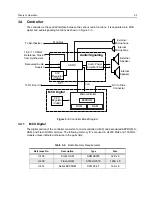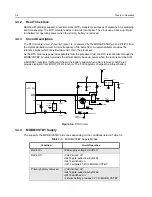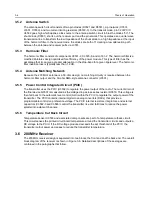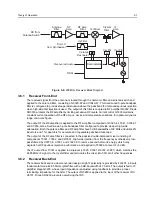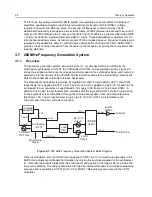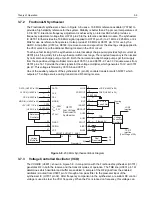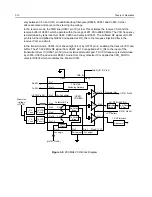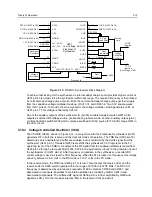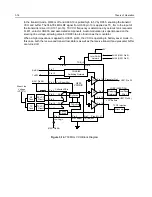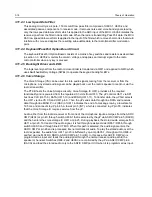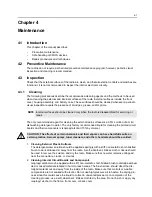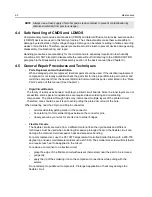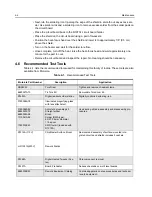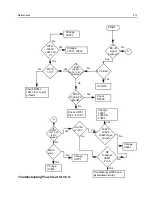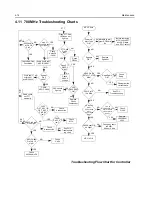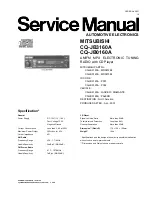
Theory of Operation
3-17
3.11 Trunked Radio Systems
Trunked systems allow a large number of users to share a relatively small number of frequencies or
repeaters without interfering with each other. The airtime of all the repeaters in a trunked system is
pooled, which maximizes the amount of airtime available to any one radio and minimizes channel
congestion. A benefit of trunking is that the user is not required to monitor the system before
transmitting.
3.11.1
LTR
®
Trunked Systems
LTR is a transmission based trunking protocol developed by the E. F. Johnson Company for primarily
single site trunking applications. In transmission trunking, a repeater is used for only the duration of a
single transmission. Once a transmission is completed, that repeater becomes available to other
users.
3.11.2
PassPort
®
Trunked Systems
PassPort is an enhanced trunking protocol developed by Trident Microsystems that supports wide
area dispatch networking. A network is formed by linking several trunked sites together to form a
single system. This offers users an extended communication coverage area. Additionally, users with
PassPort can seamlessly roam among all sites within the network. Seamless roaming means that the
radio user does not have to manually change the position on the radio when roaming from site-to-site.
All 200 MHz and 700 MHz models feature PassPort Trunking operation, and the standard keypad
board is replaced with the PassPort Trunking Controller Board (PTCB). This board also provides
advanced voice storage features. Refer to Figure 3-2 for connector and signal routing from, to and
through the Radio, PTCB and Liquid Crystal Display (LCD) sub-systems.
3.11.2.1 Power Supplies
The radio supplies regulated Vdd of 3.3 VDC. This is used to power the Low Speed Data Filter and
Voice Storage circuits. The radio also supplies Switched Battery Voltage (SWB+). U612 regulates the
SWB+ to 3.3V which is applied to the PTCB microcontroller U601. A filtered voltage (Vdda) of Vdd/2
is developed by U603-4 and is used to supply a clean reference bias for the Low Speed Data filter and
Voice Storage circuits. U610 regulates the SWB+ voltage to 3.3V which is applied to the PTCB Voice
Storage IC, U611, as well.
3.11.2.2 Microcontroller (MCU)
PassPort Trunking operation is managed by the reprogrammable FLASH ROM based microcontroller
(U601). The MCU clock oscillator uses 7.9488 MHz crystal Y601 as a stable resonator. The PTCB
communicates with the main radio microcontroller by attaching to the same Serial Peripheral (SPI)
bus that passes though the PTCB to the LCD on the CLK, DATA, RDY, and MISO lines. The OPT_EN
line is strobed low only for communications with U601.
The MCU includes an on-chip Analog to Digital Converter (ADC). The received and filtered sub-
audible low speed trunking data waveform is applied to one of the ADC inputs. The software in the
MCU decodes and acts upon the trunking data.
The MCU includes a Digital to Analog Converter (DAC). As required, the MCU software generates
appropriate PassPort Low Speed Trunking Data waveforms. These are applied to the Low Speed
Data Filter and then to the radio transmitter modulation point. The amplitude of this waveform and the
resulting transmitted deviation is controlled by software.
Summary of Contents for HT1250-LS+
Page 10: ...viii ...
Page 12: ...x Product Safety and RF Exposure Compliance ...
Page 16: ...1 4 Introduction ...
Page 58: ...4 22 Maintenance ...
Page 64: ...5 6 Schematic Diagrams Overlays and Parts Lists ...

